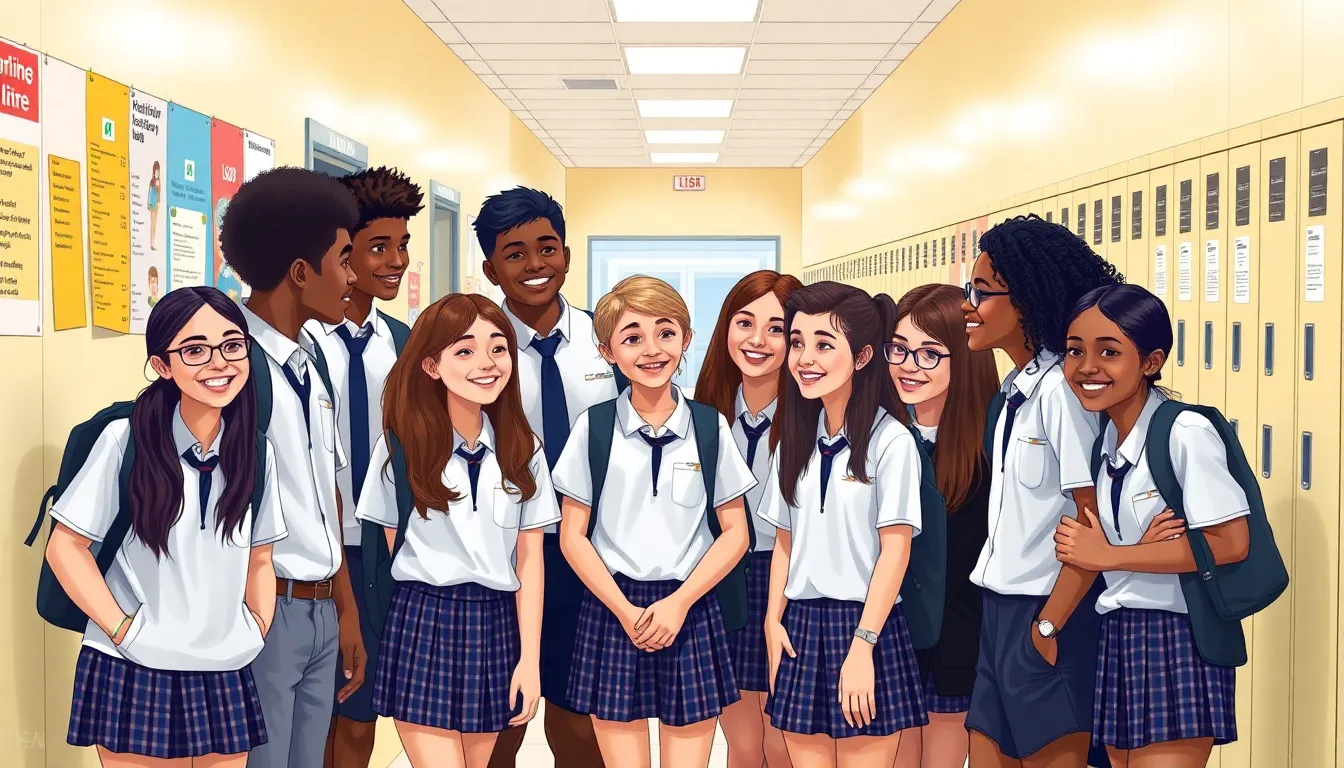In a world where fashion choices can spark debates fiercer than a heated game of dodgeball, school uniforms take the stage as the unsung heroes of student life. Picture this: no more morning wardrobe meltdowns or sibling squabbles over who borrowed whose favorite shirt. Instead, students don their crisp uniforms, ready to conquer the day like mini superheroes, all while avoiding the fashion faux pas that can haunt them for years.
But it’s not just about saving time and avoiding drama. School uniforms promote a sense of unity and equality among students, turning classrooms into inclusive spaces where everyone can focus on what truly matters—learning. So, whether you’re pro-uniform or still clinging to the dream of a casual Friday every day, it’s time to dive into the fascinating world of school uniforms and discover their impact on education and student life.
Table of Contents
ToggleOverview Of School Uniforms
School uniforms play a vital role in shaping educational environments. Standardized attire fosters equality among students, eliminating visible discrepancies related to socioeconomic status. Many schools adopt uniforms to create a cohesive atmosphere, encouraging unity among diverse student populations.
Research indicates that uniforms can reduce distractions within classrooms. Students wearing similar clothing tend to concentrate more on academic performance than on fashion trends. By simplifying morning routines, uniforms also minimize decision fatigue, allowing students to focus on their studies.
Numerous studies link school uniforms to improved student behavior. The presence of a uniform can instill discipline and a sense of responsibility. For instance, schools with uniform policies often report decreased instances of bullying and peer pressure.
Different types of uniforms exist to suit various educational institutions. Traditional options often include blazers, slacks, shirts, and skirts, while some schools may opt for casual attire like polo shirts and khakis. Each type serves to maintain a standard appearance that reinforces school identity.
Parental support plays a key role in uniform implementation. Many parents appreciate the reduction in clothing expenses associated with a uniform policy. As a result, schools may experience higher satisfaction rates among families, contributing to overall school morale.
School uniforms address multiple aspects of student life, from equality and focus to behavioral improvements and cost-effectiveness. Adopting a uniform policy has proven benefits that enhance the educational experience for all students involved.
Benefits Of School Uniforms

School uniforms offer multiple advantages for students, positively impacting their educational experiences. These benefits extend to improved student focus and fostering equality among peers.
Improved Student Focus
School uniforms directly enhance student concentration in the classroom. By minimizing distractions related to fashion choices, students can direct their attention to lessons and assignments. Studies reveal that when students wear uniforms, academic performance often improves, as distractions are significantly reduced. The mental energy previously spent on wardrobe decisions now shifts towards learning and engagement. Schools report that classrooms with uniform policies see increased participation and a stronger focus on educational objectives.
Fostering Equality
Fostering equality stands as one of the primary benefits of school uniforms. When all students wear the same attire, socioeconomic disparities diminish. Uniforms create a level playing field, significantly reducing instances of bullying based on clothing choices. Many institutions observe that this equality cultivates a sense of belonging, encouraging collaboration and camaraderie. This shared dress code promotes unity among students, allowing them to bond over common experiences rather than differences in their backgrounds. More inclusive environments emerge when appearance no longer dictates social dynamics.
Drawbacks Of School Uniforms
While school uniforms offer various benefits, they also present several shortcomings that warrant consideration.
Limitations On Personal Expression
School uniforms restrict students’ ability to express individuality. Many students feel that clothing choices are a vital form of self-expression, allowing them to showcase their personalities. Uniform policies eliminate this option, leading to frustration among students who desire freedom to choose their attire. The inability to wear personal style may hinder creativity and self-confidence, particularly during formative years. Students who cannot express themselves through clothing may struggle with identity and peer acceptance. In addition, this restriction can diminish overall enjoyment of school experiences.
Financial Burden On Families
Though uniforms can reduce school clothing expenses, they may still impose financial challenges on some families. Initial costs for purchasing specific uniforms can be higher than buying regular clothes. Families often must invest in multiple sets to accommodate school requirements. These expenses can create additional financial pressure, especially for low-income households. Moreover, if uniforms get lost or damaged, replacement costs add to the burden. Parents often find it challenging to balance these expenses with other necessary costs of education, such as supplies and extracurricular activities.
School Uniform Policies
School uniform policies establish guidelines for attire in educational settings. These policies vary significantly between public and private institutions, impacting student life and learning experiences.
Implementation In Public Schools
Public schools typically enforce specific uniform policies to promote equality. Many districts require students to wear designated colors and styles, fostering a cohesive environment. Studies indicate that implementing uniforms can lead to improved attendance and behavior. With reduced distractions from fashion, students focus more on academics. Parents often support these policies due to decreased clothing costs associated with choosing daily outfits. Uniforms in public schools help bridge socioeconomic gaps, ensuring all students can participate equally.
Variations In Private Schools
Private schools often exhibit more flexibility in uniform policies. Dress codes may incorporate specific colors, styles, or emblems representing the institution. While some schools mandate uniforms, others allow students slight personalization options, fostering self-expression. Research shows that varying uniform standards can influence student satisfaction and retention. Classes frequently emphasize the importance of discipline, aligning academic performance with uniform adherence. Parents may appreciate the distinct identity uniforms create, enhancing a school’s reputation in the community. Hence, uniform policies in private schools can reflect the institution’s values and mission.
School uniforms play a pivotal role in shaping the educational landscape. By promoting equality and reducing distractions, they foster an environment conducive to learning. Students can concentrate on academics rather than fashion choices, which enhances classroom participation and discipline.
While some may argue that uniforms limit personal expression, the benefits of unity and reduced bullying often outweigh these concerns. The financial implications for families also merit consideration, as uniforms can lead to savings in the long run.
Ultimately, the adoption of school uniforms can create a more inclusive and focused atmosphere, benefiting students, educators, and families alike.






